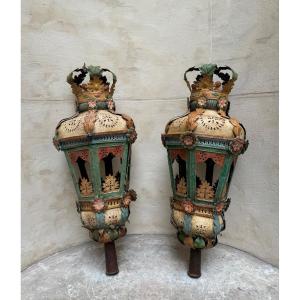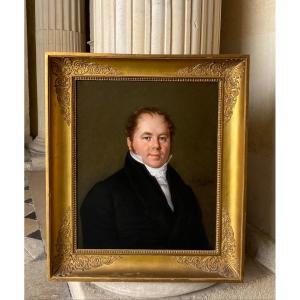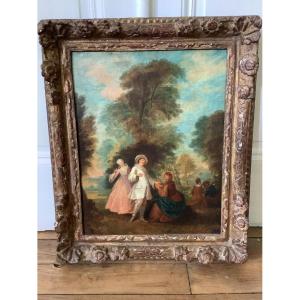Among the works of art, no doubt, a painting by Boucher or Fragonard on the wall.
Oil on panel, very good condition. Louis XVI end period.
Jean-Frédéric Schall, born March 14, 1752 in Strasbourg and died March 24, 1825 in Paris, was a French genre and portrait painter.
After having received his initial training at the Public School of Drawing in Strasbourg, Schall, still young, went to Paris in June 1772. Admitted to the School of Protected Students of the Royal Academy, under the patronage of Nicolas Guy Brenet, he entered the studio of Francesco Casanova and completed his studies in 1777. Protected by Johann Heinrich Eberts and Johann Georg Wille, and by Georges-Frédéric Meyer in Ermenonville, then by Jean-Baptiste Lemoyne, he was successively the pupil of young Jollain, in 1775, and of Lépicié fils, from 1776 to 1779.
From 1776, he produced his first works as a painter of gallant subjects in the manner of Fragonard and Debucourt. Dating from this period, his first works the Offering to Love (1776) and the Morning and the Afternoon were engraved in color by Bonnet in 1778. When he left the school, his relations brought him into contact with the high society of his time, of which he will quickly become the favorite painter. It represents the gallant parties given in the "Folies" and the "Small Houses" of the financiers and the powerful, to the actresses, dancers, frivolous and gallant fashionable women who are their mistresses.
First in the service of Duke Christian IV of Deux-Ponts, he painted, for his Secret Museum, the Faithful Indiscreet, Finish! and the Pantoufle, works in a very daring style and engraved by Gabriel Marchand or Nerbé. Among the other Strasbourg residents to protect him was the piano maker Sebastian Erhard, for whom he performed the Bouquet Impromptu. The growing success met by his work committing him to persevere in the way in which he had launched himself from the beginning of his career, he will persevere, until the end of his career, in this way and this style of books, calling himself a "history painter". Witness, in a sometimes scabrous genre, of the sweetness of life of the ending Ancien Régime, memoirist of loose morals, in a setting that is both realistic and imaginary, he becomes a minor master in the style of Fragonard and Watteau. During the Revolution, he was forced to produce "patriotic" works, but circumvented the prohibitions by using mythological themes. He exhibited at the salons from 1793 to 1806. He painted stage artists, illustrated literary works.
Boilly represented, in his painting Réunion d'artistes dans l'atelier d'Isabey, Schall at the time of the Directory, when he was living with his wife, Marie-Catherine Naudé, married in 1787, and his daughters, at the Louvre, staircase in chapel no. 22, then in the phalanstery of artists established rue Childebert on the ruins of the former abbey of Saint-Germain-des-Prés.
In addition to his genre scenes, not devoid of satirical intentions, and his gallant parties, he also portrayed the actresses and dancers of his time, such as Dugazon, Sophie Arnould, Dazincourt, Louise Contat of the Comédie-Française, as well as directed many scenic portraits of dancers, often accompanied by their replicas with variants, intended to decorate the study of their wealthy patrons, or the salons of the gallant "Societies" of which they were a part.
Schall has also abundantly illustrated literary works, such as Paul and Virginia, Paradise Lost, the Loves of Psyche and Cupid by La Fontaine, and especially the Confessions of Rousseau: having met the latter in person at Ermenonville, at the Marquis de Girardin's, Schall made the portrait of him reproduced many times under the title: the Man of Nature. For the Confessions, he produced an important suite: the Kiss given, the Kiss received, Madame de Warens initiated to love, the Sweet Resistance, the Stream, the Cherries, taken up by the chisel of many engravers, like most of his works immediately engraved, often in color, by artists such as Alexandre Chaponnier, who engraved the Pleasures of Hymen and The Dangerous Example or the Desires of Love, Louis-Marin Bonnet, Nicolas Colibert, Charles- Melchior Descourtis, Augustin-Claude-Simon Legrand and many others.
Forced by the Revolution to develop his themes towards more austere motifs, he tried for some time to get up to date with compositions in the patriotic genre, such as the Allegory of Liberty, where we see two children kissing at the foot of a Statue of Liberty, the Heroism of William Tell, or General Lacombe-Saint-Michel delivering the French from Tunis (1797), but quickly returned to his favorite subjects of youth, as soon as events allowed him to, the Revolution being far from having deprived him of his public, events having not changed the taste of the vast majority of amateurs, who had remained with him. faithful. Schall returns, under the pretext of mythology, to the licentious subjects representing naked women in bucolic landscapes which made his success], exhibiting at the Salons of 1793, 1798 and 1806, where his sending, the False Appearance (1798), is crowned by the Jury of Arts.








































 Le Magazine de PROANTIC
Le Magazine de PROANTIC TRÉSORS Magazine
TRÉSORS Magazine Rivista Artiquariato
Rivista Artiquariato